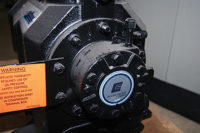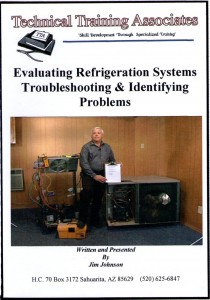It is the action of the oil safety control we will discuss in this article.

Oil Safety Controls
There are several types of oil safety control devices on the market today. The two basic controls we are most familiar with are the mechanical differential control and the pressure-sensing electronic control.The mechanical control uses tubing that senses the suction pressure of the compressor and the outlet oil pressure of the pump. The electronic control has a special pressure sensor that mounts in the outlet of the pump and connects only with an electrical cable.
In the mechanical control, the total pressure from the pump (less the suction pressure) is the actual net oil pressure. The control requires manual reset once it is tripped.
In the electronic control, the pressure sensor sends a signal to the control module whenever the pressure sensed falls below 7 to 9 psig. This signal causes the control module to open the safety contact points after a time delay.
This control also requires manual reset once it has tripped. On both controls, the opening of the safety contacts breaks the electrical current in the system control circuit.
When the service person gets a call that the refrigeration system is not operating, one thing checked is whether the oil safety control has tripped. If it has tripped, the fun begins when the mechanic must figure out what caused the oil failure control to open.
Sometimes the actual cause of the trip is obvious; for example, when there is no oil showing in the crankcase sight glass. Often, however, the cause is not noticed and is more difficult to figure out, calling for detective work to keep the refrigeration system operating.
Oil Pressure Control Checklist
The following is a general list of possible causes of oil failure trips:
- Low compressor oil level;
- The system refrigerant piping is not designed or sized properly;
- The system has not been properly adjusted and balanced;
- Lack of proper “winter charge” of refrigerant (low refrigerant);
- Refrigerant migration;
- The system controls have not been properly set;
- Electrical problems; and
- Compressor problems.
Compressor Oil Level
If you can’t see the oil level in the crankcase sight glass, there is either too much oil in the compressor or not enough. In most compressors, the oil level in the sight glass should be between one-fourth and one-half the sight glass.Too little oil in the compressor results in an obvious oil trip. Too much oil in the compressor can also cause oil trips. Excessive oil can cause enough turbulence in the crankcase to result in a low net oil pressure.
In another twist of too much oil in the sight glass, the high level of oil may be caused by liquid refrigerant in the crankcase. The liquid refrigerant could be mixed with the oil or collected beneath the oil on the bottom of the crankcase. In either case, the refrigerant in the crankcase will cause the net oil pressure to be low.
If there is too much oil in the crankcase, the excessive oil should be drained to the proper level. If there is not enough oil in the crankcase, you must find the reason the oil has not returned to the compressor.
System Piping
If the oil does not properly return to the compressor, it could be due to system piping and/or design.For oil return, the suction pipe is the most critical. The suction pipe should slope toward the compressor and should be sized for minimum pressure drop and proper refrigerant velocities.
Minimum pressure drop and proper gas velocities can conflict with each other by their nature, so take care in selecting pipe sizes.
If the pipe size selected is too large, the refrigerant velocity becomes insufficient to carry oil vertically up the pipe.
Low refrigerant velocities result in poor oil return to the compressor. The oil must pass freely through the entire system and reach a state of equilibrium to maintain stable levels in the compressor.

Oil Traps and Suction Risers
Equally important in the system piping design is the use of traps in the suction line.A p-trap should be used at the base of any suction riser greater than 3 to 4 ft in length. A suction riser is any vertical line that has an upward refrigerant flow.
In long suction risers, p-traps should be used for each 20 ft of vertical rise. In addition, it is good practice to install a p-trap at the outlet of the evaporator if the suction line rises above the bottom of the evaporator. This trap will ensure that oil can flow freely out of the evaporator.
The reason for the suction p-trap is to help the return of oil to the compressor. The refrigerant gas returning from the evaporator will contain drops of oil that can collect and mix in the turbulence of the trap. This turbulent action breaks up the larger drops of oil into smaller droplets carried up the riser pipe by the gas velocity.
Be careful of piping installations where the pipe is being routed over, around, or under obstacles. This can inadvertently create unwanted traps in the return line that will collect oil.
If possible, the refrigerant line should travel a direct and straight course between the evaporator and compressor.
New Systems
Sometimes not enough oil is added to a new system to allow for the pipe, accumulators, separators, suction traps, evaporators, and condensers.There is always a certain amount of oil in the system that will stay disbursed throughout the system after stabilization and during normal operation.
Use extreme care when adding oil to a new system. Most compressors are shipped with enough oil to carry through systems up to 50 ft of piping without additional oil.
Always check the system for possible problems before adding oil to the compressor. Barring leaks and other unforeseen problems, oil should never have to be added to a stabilized system.
System Balance
A refrigeration system should be fine tuned after installation and start-up.Never assume that the thermal expansion valve installed at the evaporator is preset. Each expansion valve has an adjustment stem for a definite purpose. The purpose is to fine tune the system for your particular conditions and application.
Several problems can prevent the user from achieving stable operating conditions. Fine tuning the system is vital to oil control. The distributor, and the nozzle inserted into the distributor, have become vital parts of the refrigeration system, adversely affecting operation if not sized correctly.
Factors affecting these parts are evaporator capacity, liquid refrigerant temperature, suction temperature, and refrigerant type. Usually, a standard nozzle is shipped with a particular evaporator sized for the standard capacity of the coil, normal liquid refrigerant temperatures of 90° to 100°F, and the refrigerant type.
If any of the conditions deviate from the standard, such as mechanical subcooling the liquid refrigerant below 80°, the distributor and nozzle may not perform properly.
When a problem exists, the system cannot maintain the required fixture temperature and/or the suction superheat is erratic and unstable. In the worst case, if the suction superheat is too low, it causes liquid floodback to the compressor.
Seasonal Changes
A significant number of oil control trips occur during the “swing” times of the year, when the night temperatures are cold and day temperatures are warm. Often the mechanic finds the compressor not operating during the day because of an oil control trip.When the cause of the failure is not readily apparent, the control is reset, the compressor operates normally, and everything looks good from the refrigeration perspective.
Here are some reasons for oil failure:
- Inadequate refrigerant in systems designed to flood the condenser will cause low suction pressures.
- If refrigerant charge is low, the expansion valve will not feed the evaporator properly, resulting in high superheat and low gas velocities.
- Low head pressure resulting from the cold ambient can affect the thermal expansion valve.
Migration
Migration occurs on cold nights because of pressure differences. Refrigerant will always move from warmer areas to colder areas. Therefore, when the compressor is off, the refrigerant will migrate to the coldest part of the system.Migration can be controlled with the use of a pumpdown solenoid. This requires a liquid solenoid valve installed in the liquid line of the system.
Whenever the system is defrosting or satisfied on temperature, the liquid solenoid valve should be closed. This will help reduce the potential for refrigerant migration to the compressor.
System controls
It is important that the controls in the refrigeration system be properly set. This would include low-pressure controls, head pressure controls, condenser fan recycling controls, and any other type control that special systems and circumstances require.
All valves that can change system pressures should also be included in this section.
Check manufacturer specifications for proper settings of all valves and controls. Improper settings could result in oil pressure trips when least expected.

Electrical
Oil pressure trips can be caused by electrical problems. An electrical problem that causes the motor windings inside the compressor to overheat can cause internal overload in the compressor to open.The compressor is not operating and not producing oil pressure, yet the oil pressure control is still energized and monitoring the oil system. After the specified time-out period for the control, the contacts will open and the oil safety control must be manually reset.
Possible electrical problems include high voltage, low voltage, phase imbalance on three-phase systems, and phase loss on three-phase systems.
“Electrical noise” is another type of electrical problem that can cause an oil control trip. Sensitivity to line noise and an inordinate amount of electrical transients on incoming lines can cause the noise. Local electrical characteristics can also cause electronic oil control failure.
Compressor Problems
There are several compressor problems that can cause the oil failure control to trip.
- A worn or defective oil pump usually produces no net oil pressure.
- Smaller horsepower compressors can trip an oil failure if the compressor does not start when electrical power is applied to the terminals.
- Oil contamination can cause a problem at the pick-up tube in the compressor crankcase.
- In older compressors, oil failures can occur because of the pressurization of the crankcase due to blow-by from the pistons or piston rings.
- Short cycling occurs when the compressor pumps more oil than normal and can cause the oil control to trip.
Reprinted from Tech Topics, published by Heatcraft, Inc.








